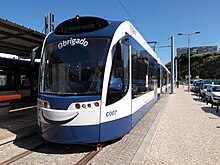Tram
Most trams use electrical power, usually fed by a pantograph sliding on an overhead line; older systems may use a trolley pole or a bow collector.One of the advantages over earlier forms of transit was the low rolling resistance of metal wheels on steel rails, allowing the trams to haul a greater load for a given effort.[8] The Swansea and Mumbles Railway was something of a one-off however, and no street tramway appeared in Britain until 1860 when one was built in Birkenhead by the American George Francis Train.[13] The tram was developed in numerous cities of Europe (some of the most extensive systems were found in Berlin, Budapest, Birmingham, Saint Petersburg, Lisbon, London, Manchester, Paris, Kyiv).In 1905 the British newspaper Newcastle Daily Chronicle reported that, "A large number of London's discarded horse tramcars have been sent to Lincolnshire where they are used as sleeping rooms for potato pickers".[25] From 1885 to 1940, the city of Melbourne, Victoria, Australia operated one of the largest cable systems in the world, at its peak running 592 trams on 75 kilometres (47 mi) of track.[citation needed] In Dresden, Germany, in 1901 an elevated suspended cable car following the Eugen Langen one-railed floating tram system started operating.[citation needed] Cable cars remained especially effective in hilly cities, since their nondriven wheels did not lose traction as they climbed or descended a steep hill.[citation needed] The San Francisco cable cars, though significantly reduced in number, continue to provide regular transportation service, in addition to being a well-known tourist attraction.Another system, with two separate cable lines and a shared power station in the middle, operates from the Welsh town of Llandudno up to the top of the Great Orme hill in North Wales, UK.Galveston Island Trolley in Texas operated diesel trams due to the city's hurricane-prone location, which would have resulted in frequent damage to an electrical supply system.Gas trams are known to have operated between Alphington and Clifton Hill in the northern suburbs of Melbourne, Australia (1886–1888); in Berlin and Dresden, Germany; in Estonia (1921–1951); between Jelenia Góra, Cieplice, and Sobieszów in Poland (from 1897); and in the UK at Lytham St Annes, Trafford Park, Manchester (1897–1908) and Neath, Wales (1896–1920).[35] Earlier electric trains proved difficult or unreliable and experienced limited success until the second half of the 1880s, when new types of current collectors were developed.While this line proved quite versatile as one of the earliest fully functional electric streetcar installations, it required horse-drawn support while climbing the Niagara Escarpment and for two months of the winter when hydroelectricity was not available.[37][38][39][40][41] Short pioneered "use of a conduit system of concealed feed" thereby eliminating the necessity of overhead wire and a trolley pole for street cars and railways.[50] Electric systems were also built in Adelaide, Ballarat, Bendigo, Brisbane, Fremantle, Geelong, Hobart, Kalgoorlie, Launceston, Leonora, Newcastle, Perth, and Sydney.In recent years the Melbourne system, generally recognised as the largest urban tram network in the world, has been considerably modernised and expanded.In this event, the underframe of the tram, by virtue of a circuit path through ancillary loads (such as interior lighting), is live at the full supply voltage, typically 600 volts DC.In the 2000s, several companies introduced catenary-free designs: Alstom's Citadis line uses a third rail, Bombardier's PRIMOVE LRV is charged by contactless induction plates embedded in the trackway and CAF URBOS tram uses ultracaps technology[59][60] As early as 1834, Thomas Davenport, a Vermont blacksmith, had invented a battery-powered electric motor which he later patented.[61][62] Attempts to use batteries as a source of electricity were made from the 1880s and 1890s, with unsuccessful trials conducted in among other places Bendigo and Adelaide in Australia, and for about 14 years as The Hague accutram of HTM in the Netherlands.In March 2015, China South Rail Corporation (CSR) demonstrated the world's first hydrogen fuel cell vehicle tramcar at an assembly facility in Qingdao.The success of the PCC streetcar had also seen trams use automobile-style foot controls allowing hands-free operation, particularly when the driver was responsible for fare collection.[71] The old tram systems in London, Manhattan (New York City), and Washington, D.C., used live rails, like those on third-rail electrified railways, but in a conduit underneath the road, from which they drew power through a plough.More recently, an equivalent to these systems has been developed which allows for the safe installation of a third rail on city streets, known as surface current collection or ground-level power supply; the main example of this is the new tramway in Bordeaux.Some have a rational structure, covering their catchment area as efficiently as possible, with new suburbs being planned with tramlines integral to their layout – such is the case in Amsterdam.In some places, the opportunity is taken when roads are being repaved to lay tramlines (though without erecting overhead cables) even though no service is immediately planned: such is the case in Leipzigerstraße in Berlin, the Haarlemmer Houttuinen in Amsterdam, and Botermarkt in Ghent.Before its system was converted to trolleybus (and later bus) services in the 1930s (last tramway closed 6 July 1952), the first-generation London network had 555 km (345 mi) of route in 1931.The Saint Petersburg Tram Company[135] produces highly detailed polyurethane non-powered O Scale models from around the world which can easily be powered by trucks from vendors like Q-Car.[139] Although the terms tram and tramway have been adopted by many languages, they are not used universally in English; North Americans prefer streetcar, trolley, or trolleycar."Trolley" and variants refer to the verb troll, meaning "roll" and probably derived from Old French,[141] and cognate uses of the word were well established for handcarts and horse drayage, as well as for nautical uses.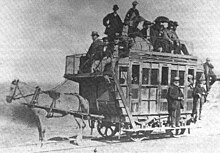
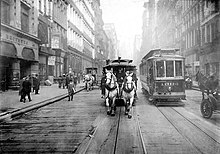








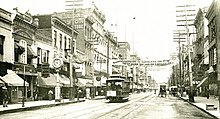


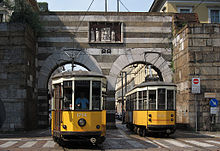










Countries with tram networks
Countries without tram networks
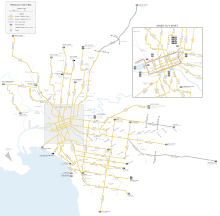
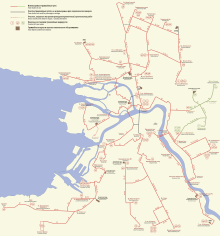




Tram (disambiguation)Streetcar (disambiguation)trackless trainRail transportHistoryCompany typesManagementRail yardRailway stationRailway trackTrack gaugerolling stockBogie (truck)CouplingsFreightLocomotivesMultiple unitsPassenger trainCommuterHigh-speedInter-cityRegionalRail subsidiesRailroad carsOperatingTrainsMaglevMonorailUrban rail transitLight railInterurbanRapid transitAutomatedAccidentsBy countryCompaniesList of high-speed trainsLongest train servicesModellingMuseumsPlatform screen doorsRailway speed recordSuicideTerminologyTatra T3vehiclesrailcarsmultiple-unittramway tracksright-of-waypublic transportmain linepantographoverhead linetrolley polebow collectorcontact shoethird railtram-trainsrolling resistancetotal cost of ownershipHistory of tramswagonwaysmine cartsplatewayscast ironHorsecarSwansea and Mumbles RailwayBirkenheadGeorge Francis TrainpavinghorsebusesBaltimoreNew York and Harlem RailroadJohn StephensonFourth Avenue LineBoweryFourth AvenueNew Orleans and Carrollton RailroadNew Orleans, LouisianaSt. Charles Streetcar LineAlphonse LoubatBudapestBirminghamSaint PetersburgLisbonLondonManchesterSantiago, ChileSydneyAlexandriaBatavia (Jakarta), Netherlands East Indies (Indonesia)Lincolnshirepotato pickersNew York CityBleecker Street LinePittsburgh, PennsylvaniaSulphur Rock, ArkansasU.S. postage stampMexico CityCelaya, MexicoFintonaUlster Transport MuseumDouglas Bay Horse TramwayIsle of Manhorse tramVictor HarborSouth AustraliaHokkaidōDisneylandPolishgmina MrozyTram engineSteam dummyCologne-Bonn RailwayBrühlsteam locomotiveChristchurchNew South WalesMunichBritish IndiaMagentaRockhamptonQueenslandStockholmSödermalm




